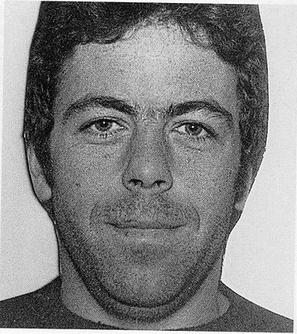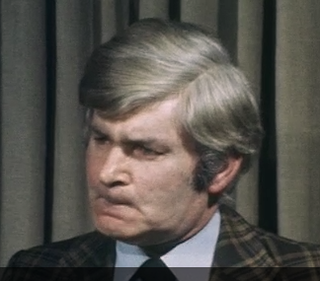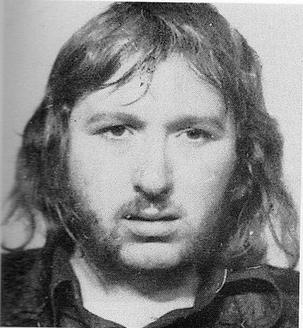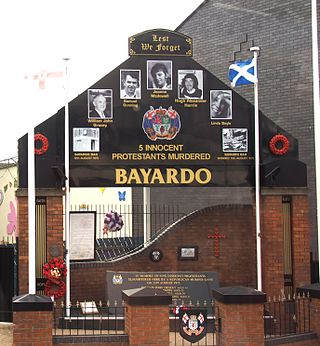The Shankill Butchers were an Ulster loyalist paramilitary serial killer gang – many of whom were members of the Ulster Volunteer Force (UVF) – that was active between 1975 and 1982 in Belfast, Northern Ireland. It was based in the Shankill area and was responsible for the deaths of at least 23 people, most of whom were killed in sectarian attacks.

William Moore was a Northern Irish loyalist. He was a member of the Shankill Butchers, an Ulster Volunteer Force (UVF) gang. It was Moore who provided the black taxi and butcher knives which the gang used to carry out its killings. Following ringleader Lenny Murphy's arrest, Moore took over as the de facto leader of the gang and the killings continued.

Hugh Leonard Thompson Murphy was a Northern Irish loyalist and UVF officer. As leader of the Shankill Butchers gang, Murphy was responsible for the murders of mainly Catholic civilians, often first kidnapping and torturing his victims. Due to a lack of evidence, Murphy was never brought to trial for these killings, for which some of his followers had already received long sentences in 1979.
Diplock courts were criminal courts in Northern Ireland for non-jury trial of specified serious crimes. They were introduced by the Northern Ireland Act 1973 and used for serious and terrorism-related cases during the Troubles. The Justice and Security Act 2007 ended the automatic use of non-jury trials for scheduled offences but they are still used in Northern Ireland upon certification by the Director of Public Prosecutions on a case-by-case basis.

On 19 March 1988, the British Army corporals Derek Wood and David Howes were killed by the Provisional IRA in Belfast, Northern Ireland, in what became known as the corporals killings.

The Shankill Road bombing was carried out by the Provisional Irish Republican Army (IRA) on 23 October 1993 and is one of the most well-known incidents of the Troubles in Northern Ireland. The IRA aimed to assassinate the leadership of the loyalist Ulster Defence Association (UDA), supposedly attending a meeting above Frizzell's fish shop on the Shankill Road, Belfast. Two IRA members disguised as deliverymen entered the shop carrying a bomb, which detonated prematurely. Ten people were killed: one of the IRA bombers, a UDA member and eight Protestant civilians, two of whom were children. More than fifty people were wounded. The targeted office was empty at the time of the bombing, but the IRA had allegedly realised that the tightly packed area below would inevitably cause "collateral damage" of civilian casualties and continued regardless. However, the IRA have denied this saying that they intended to evacuate the civilians before the explosion. It is alleged, and unearthed MI5 documents appear to prove, that British intelligence failed to act on a tip off about the bombing.

John Dunlop McKeague was a Northern Irish loyalist and one of the founding members of the paramilitary group the Red Hand Commando in 1970. A number of authors on the Troubles in Northern Ireland have accused McKeague, a homosexual paederast, of involvement in the Kincora Boys' Home scandal but he was never convicted. He was shot dead by the Irish National Liberation Army (INLA) in Belfast in January 1982.
Events during the year 1982 in Northern Ireland.
John Alexander Thompson Murphy was a Northern Irish loyalist. He was one of the three leading men in the "Shankill Butchers", an Ulster Volunteer Force (UVF) gang.

Robert William Bates was a Northern Irish loyalist. He was a member of the Ulster Volunteer Force and the infamous Shankill Butchers gang, led by Lenny Murphy.
This is a timeline of actions by the Ulster Volunteer Force (UVF), an Ulster loyalist paramilitary group since 1966. It includes actions carried out by the Red Hand Commando (RHC), a group integrated into the UVF shortly after their formation in 1972. It also includes attacks claimed by the Protestant Action Force (PAF), a covername used by the UVF. Most of these actions took place during the conflict known as "the Troubles" in Northern Ireland.

William "Frenchie" Marchant was a Northern Irish loyalist and a high-ranking volunteer in the Ulster Volunteer Force (UVF). He was on a Garda list of suspects in the 1974 Dublin car bombings, and was allegedly the leader of the Belfast UVF unit known as "Freddie and the Dreamers" which hijacked and stole the three cars which were used in the bombings.

James Pratt Craig was a Northern Irish loyalist paramilitary during The Troubles in Northern Ireland in the latter half of the 20th century, who was a member of the Ulster Defence Association (UDA), and a command member of its Inner Council. He also ran a criminal large-scale protection racket from the West Belfast Shankill Road area, where he resided. Described by journalist David McKittrick as "Belfast's foremost paramilitary extortionist", Craig allegedly colluded at times with the enemies of the UDA, Irish Republican groups such as the Provisional Irish Republican Army (IRA) and Irish National Liberation Army (INLA), providing them with information on key loyalists which led to their subsequent murders. Aside from controlling rackets and extorting protection money from a variety of businesses, it was claimed that Craig also participated in paramilitary murders.

The Bayardo Bar attack took place on 13 August 1975 in Belfast, Northern Ireland. A unit of the Provisional Irish Republican Army (IRA), led by Brendan McFarlane, launched a bombing and shooting attack on a pub on Aberdeen Street, in the loyalist Shankill area. IRA members stated the pub was targeted because it was frequented by members of the Ulster Volunteer Force (UVF). Four Protestant civilians and one UVF member were killed, while more than fifty were injured.
The Chlorane Bar attack was a mass shooting at a city centre pub on 5 June 1976 in Belfast, Northern Ireland. It was carried out by the Ulster Volunteer Force (UVF), an Ulster loyalist paramilitary organisation, apparently in retaliation for the Provisional IRA bombing attack on the Times Bar on York Road, in which two Protestant civilians were killed. In the Chlorane attack, five civilian men were killed; three Catholics and two Protestants. The gunmen were militants from the UVF Belfast Brigade's Shankill Road battalion. The assault was a joint operation by the platoons based at the Brown Bear and the Windsor Bar, drinking haunts in the Shankill Road district frequented by UVF members.

James Nesbitt MBE was a Royal Ulster Constabulary (RUC) Detective Chief Inspector who was best known for having headed the Murder Squad team investigating the notorious Shankill Butchers' killings in the mid-1970s. Working from the C Division headquarters at Tennent Street off Shankill Road, Belfast, he eventually caught most of the "Butchers" which led to their convictions. Having received a total of 67 commendations throughout his career, this is the highest number for any policeman in the history of the United Kingdom. In 1980, he was given the MBE "in recognition of his courage and success in combating terrorism".

The Young Citizen Volunteers of Ireland, or Young Citizen Volunteers (YCV) for short, was a loyalist paramilitary organisation for loyalist youths which later became the youth wing of Ulster loyalist paramilitary group the Ulster Volunteer Force. It appropriated the name of the original Young Citizen Volunteers formed in 1912 as a British civic organisation.
James Watt also known as Tonto is a former Northern Irish loyalist who was the top bomb maker for the Ulster Volunteer Force (UVF) in the mid-1970s. In 1978, Watt was convicted and given nine separate life sentences for murder and attempted murder. These included bombings which killed a ten-year-old boy and two teenagers in two attacks carried out in April 1977 as a part of a UVF bombing campaign against republicans.

The Hillcrest Bar bombing, also known as the "Saint Patrick's Day bombing", took place on 17 March 1976 in Dungannon, County Tyrone, Northern Ireland. The Ulster Volunteer Force (UVF), a loyalist paramilitary group, detonated a car bomb outside a pub crowded with people celebrating Saint Patrick's Day. Four Catholic civilians were killed by the blast—including two 13-year-old boys standing outside—and almost 50 people were injured, some severely.
On 2 October 1975, the loyalist paramilitary group the Ulster Volunteer Force (UVF) carried out a wave of shootings and bombings across Northern Ireland. Six of the attacks left 12 people dead and around 45 people injured. There was also an attack in a small village in County Down called Killyleagh. There were five attacks in and around Belfast which left people dead. A bomb which exploded in Coleraine left four UVF members dead. There were also several other smaller bombs planted around Northern Ireland but other than causing damage they did not kill or injure anyone.












